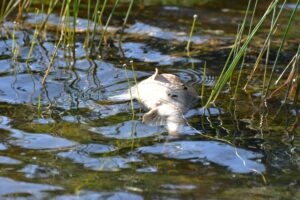by Paige Jessup, Climate Change Resiliency Intern
The loss of biodiversity in freshwater and terrestrial ecosystems has been a growing issue for freshwater communities. Run-off from improperly installed or unmaintained septic systems are one of the ways that untreated wastewater gets into freshwater bodies. Things like cracks in the tank can also cause nutrients from the wastewater to leach into the soil, which can lead to highly undesirable changes in local ecosystem structure and function.
Terrestrial Ecosystems
Impacts on Wildlife
Nitrogen and phosphorus released from septic systems can negatively impact water quality, soil chemistry, and plant biodiversity. Because of the excessive plant growth that can occur, this can lead to a jump in population of species who eat these aquatic plants, which creates competition pressures for other species. For example, a decrease in populations of like quail, partridge, rabbit, hare, and open-vegetation birds was observed on lakes experiencing nutrient-loading (Smith et al., 1999). The impact in one area of the ecosystem can have cascading impacts on all wildlife and biodiversity throughout the food chain.
Soil Degradation and Plant Health
When there is damage to the pipes or the tanks on our septic system, it allows wastewater and therefore excess nutrients such as nitrogen and phosphorus to leach into the soil before it has a chance to be fully and properly treated. This nutrient loading causes excessive plant growth which can have many negative impacts on the ecosystem, including the blocking of sunlight which prevents other plants from being able to grow, reducing food availability for wildlife, and possible fish die-offs from the plants using up all of the available oxygen in the water. Leaching of nutrients into the soil can also lead to a decrease in the quality of the soil for plants that require certain nutrients.
Aquatic Ecosystems
Water Quality
Untreated or improperly treated wastewater can have devastating consequences for water quality and other aspects of aquatic ecosystems. Nitrogen and phosphorus can enter the water by runoff from failing drain fields, and soil erosion from leaks somewhere in the septic system. When these nutrients enter the water it causes excessive plant and algae growth, enabling excessive phytoplankton growth in the top layer of the water. The plankton die and eventually sink to the bottom of the lake. When the plankton decompose they use up much of the oxygen in the water during the process.
Impacts on Fish and Other Aquatic Species
The accumulation of algae on the surface of the water blocks sunlight and starves the plants, fish, and other aquatic invertebrates of oxygen, creating a hypoxic or anoxic ‘dead zone’ that is lacking sufficient oxygen to support most organisms (Chislock, 2013). The loss of aquatic life has large ripple effects on the environment, by removing important food sources and making the water unsuitable for drinking.

The Importance of Proper Maintenance
Because there are many risks to the health of local ecosystems, it is important to properly maintain your septic system. A beginner’s list of best practices for maintenance can be found in this blog post.
This blog is part of a larger education toolkit about septic systems. To access all of the resources from the toolkit, visit watersheds.ca/septics
Your $5 donation today will ensure more landowners, municipalities, and families have access to the resources they need to protect Canada’s freshwater – donate now!
References
Chislock, M. F., Doster, E., Zitomer, R. A. & Wilson, A. E. (2013). Eutrophication: Causes, Consequences, and Controls in Aquatic Ecosystems. Nature Education Knowledge. 4(4):10
LeSher, A. (n.a.). Septic Systems Near Significant Wildlife Habitats. Sustainable Development Code. Retrieved from https://sustainablecitycode.org/brief/restrict-septic-systems-near-significant-wildlife-habitats/
Smith, V.H., Tilman, G.D., Nekola, J.C. (1999). Eutrophication: impacts of excess nutrient inputs on freshwater, marine, and terrestrial ecosystems. Environmental Pollution. 100(1–3), 179-196, https://doi.org/10.1016/S0269-7491(99)00091-3.

